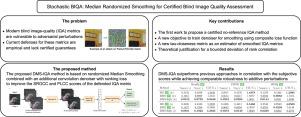随机BIQA:用于认证盲图像质量评估的中位数随机平滑
IF 3.5
3区 计算机科学
Q2 COMPUTER SCIENCE, ARTIFICIAL INTELLIGENCE
引用次数: 0
摘要
大多数现代无参考图像质量评估(NR-IQA)指标是基于易受对抗性攻击的神经网络。尽管提出了一些针对IQA指标的经验防御,但它们并没有提供理论上的保证,而且可能容易受到自适应攻击。这项工作的重点是开发一个可证明的健壮的无参考IQA度量。所提出的DMS-IQA方法是基于随机中值平滑和附加的带有排序损失的卷积去噪来提高防御IQA度量的SROCC和PLCC分数。我们从理论上证明,对于给定l2范数的所有输入扰动,防御性IQA度量的输出变化不超过预定义的delta。与之前的两种方法在三个数据集上相比,我们的方法在保持可比的认证保证的同时,显示出更高的SROCC和PLCC分数。我们还通过实验证明,将DMS-IQA防御质量度量嵌入到图像处理算法的训练中可以产生好处,但它需要额外的计算资源。我们在GitHub上提供了代码。本文章由计算机程序翻译,如有差异,请以英文原文为准。

Stochastic BIQA: Median randomized smoothing for certified blind image quality assessment
Most modern No-Reference Image-Quality Assessment (NR-IQA) metrics are based on neural networks vulnerable to adversarial attacks. Although some empirical defenses for IQA metrics were proposed, they do not provide theoretical guarantees and may be vulnerable to adaptive attacks. This work focuses on developing a provably robust no-reference IQA metric. The proposed DMS-IQA method is based on randomized Median Smoothing combined with an additional convolution denoiser with ranking loss to improve the SROCC and PLCC scores of the defended IQA metric. We theoretically show that the output of the defended IQA metric changes by no more than a predefined delta for all input perturbations bounded by a given norm. Compared with two prior methods on three datasets, our method exhibited superior SROCC and PLCC scores while maintaining comparable certified guarantees. We also experimentally demonstrate that embedding the DMS-IQA defended quality metric into the training of image processing algorithms can yield benefits, but it requires extra computational resources. We made the code available on GitHub.
求助全文
通过发布文献求助,成功后即可免费获取论文全文。
去求助
来源期刊

Computer Vision and Image Understanding
工程技术-工程:电子与电气
CiteScore
7.80
自引率
4.40%
发文量
112
审稿时长
79 days
期刊介绍:
The central focus of this journal is the computer analysis of pictorial information. Computer Vision and Image Understanding publishes papers covering all aspects of image analysis from the low-level, iconic processes of early vision to the high-level, symbolic processes of recognition and interpretation. A wide range of topics in the image understanding area is covered, including papers offering insights that differ from predominant views.
Research Areas Include:
• Theory
• Early vision
• Data structures and representations
• Shape
• Range
• Motion
• Matching and recognition
• Architecture and languages
• Vision systems
 求助内容:
求助内容: 应助结果提醒方式:
应助结果提醒方式:


